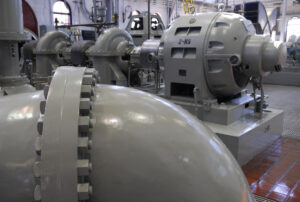Many metropolitan areas across the country face a singular, yet systemic challenge: meeting the water needs of a growing population while, at the same time, upgrading aging water systems. For Nashville Water Metro Services, which can trace its roots back to 1831, the solution to that challenge is holistic. The department has embraced a one-water philosophy, providing drinking water, wastewater, and stormwater services to the greater Nashville metro area.
Metro Water Services’ extensive water infrastructure system is uniquely adapted to the city’s hilly topography. Fifty-six pumping plants throughout the city facilitate the movement of drinking water to 89 pressure zones. Metro Water Services conveys Cumberland River water to over 660,000 customers with more than 3,000 miles of water main and 37 reservoirs. On the wastewater side, Metro Water Services runs three treatment plants and another 3,000 miles of pipe to serve nearly 750,000 people. More than 800 miles of drainage pipe routes stormwater away from residences and businesses in the city.
Metro Water Services’ leadership team knows water. Director Scott Potter has been in the water business for more than 20 years; prior to joining Metro Water Services, he served in the military for 12 years. Chief Engineer Cyrus Toosi has worked for Metro Water Services for 28 years. Ron Taylor, the program director of Clean Water Nashville, the city’s sewer overflow abatement program, has been in water industry for over 35 years—22 with Metro Water Services.
Municipal Water Leader’s editor-in-chief, Kris Polly, spoke with Metro Water Services’ leadership team about Nashville’s comprehensive approach to water management.
Kris Polly: What is the status of Metro Water Services’ infrastructure?
Scott Potter: We are fond of saying that our infrastructure is aging. I say that not to be flippant. Everyday, it is one day older, and we still have to maintain our water, wastewater, and storm water structure. The pump station for our older water treatment plant was built in 1888 and is still operating. Now, it has had lots of generational changes to it, but some of the piping is original. We have two valves on the lowest level of that utility that were cast in 1873 that water still passes through on its way to the consumers in Nashville.
Kris Polly: What are your pipes made of?
Scott Potter: The water system is mostly ductile—a mix of iron and cast iron. We have inherited some PVC.
Ron Taylor: On the wastewater side, we also have some historic infrastructure that dates back to the 1890s. We have brick sewers in the oldest part of town that were developed in the same era. The treatment plants are much newer.
Kris Polly: So you are a historic site and a water treatment facility? Scott Potter: We are. We are on the national register of historic places. It’s a beautiful building. We have 150-year-old pipe in the ground that is still in service. Interesting side note—we have two water treatment plants. The newer of those two flooded in May 2010, but that historic 1888 structure got us through the flood without losing water supply. It operated at full capacity for 30 days. It is a testament to our engineers, electricians, and mechanics—those who designed it in the first place and those who currently maintain it.
Kris Polly: How does aging infrastructure affect your day-to-day operation?
Scott Potter: People expect to have uninterrupted service for water and wastewater. Meeting that expectation is challenging. The infrastructure, as I’ve said, is older and very complicated. In addition, we have 89 pressure zones because we are in a very hilly area. In some cases, a drop of water goes through six levels of pumping before it gets through our highest pressure level. That kind of coordination can be difficult. Our pump stations greatly depend on electricity, so we need uninterrupted power at all times. In addition, the coordination of chemical deliveries cannot be interrupted. The logistics and operational coordination and repair are hard to maintain on a 365-day, 24-hour basis.
Cyrus Toosi: To echo our director, we have thousands of miles of water main. About one-third of our system was built before 1955— the pipes from that time do not have a protective coating inside the pipe. We are going back and rehabilitating that infrastructure. So for every 1,000 miles, we have probably done 200–300 miles and have about 700–800 left to go.
Like other communities across the country, Nashville has grown. Aging infrastructure robs the capacity from our system. On the wastewater side, the fluid we deal with is very corrosive. It is tough on our pumping systems—keeping up our facilities is challenging due to the medium we are pumping.
Kris Polly: Are there challenges associated with the growth of your city?
Scott Potter: Yes, there are. The city of Nashville has rebounded quickly since the recession. Our growth leveled off for a little bit, but it never went down. Now, it is growing pretty quickly. We have realized some challenges with capacity, but we have always planned ahead to keep that capacity there.
 Kris Polly: What kind of projects are you undertaking to meet the challenges of aging infrastructure and growth?
Kris Polly: What kind of projects are you undertaking to meet the challenges of aging infrastructure and growth?
Scott Potter: With respect to our sewer infrastructure, we are replacing sewer pipe lining. Basically, we are placing a new pipe within an old one. It is a cured-in-place lining system. It ends up extending the life of the pipe, because it seals cracks or leaks.
On the drinking water side of our operations, we have been cleaning the existing pipe and lining it with mortar. We also found that most leads and services need to be relined—and we will eventually be replacing those.
Cyrus Toosi: We have developed a master plan that outlines replacement of our infrastructure built in the 1890s and 1900s onward. It is a large investment with a long planning horizon.
Kris Polly: How is Metro Water Services financing these long-term projects, and how do you communicate that to your customers?
Scott Potter: Our governing body is a 40-member council. My boss is the mayor of Nashville, but the council sets the water, sewer, and storm water rates. To adjust Metro Water Services’ rates, we have to get the council’s approval. Financing the rehabilitation and replacement of our infrastructure is something we will have to address in the near future. In the meantime, we are funding most of our capital investments with bonds. We are also pursuing revolving loan funds from the state of Tennessee.
The council is unique, but I happen to think it works pretty well. We have representatives from 35 districts in our county, 5 at-large members, and a vice mayor on the council. I do not say this in a negative way, but it is very political. You are accountable to a relatively small number of people, so we get really strong neighborhood representation. It puts us in the position of having to justify what we are asking for, which is a good model.
The council meets twice a month—Metro Water Services is present at those meetings to provide a variety of perspectives. We typically do not speak directly about rates until that specific topic comes up.
Kris Polly: Please describe your experience using WIFIA [Water Infrastructure Finance and Innovation Act] and SRF [State Revolving Funds] funding.
Scott Potter: We have had really great experience with SRF funds. Also, Metro Water Services strongly supports the WIFIA approach. I think that it is good for the federal level to help the nation’s water infrastructure. We are strong proponents of that process.
On the SRF side, we have had great success. I think it is a great program, because it is accountable to the ratepayers and taxpayers. It provides us with a good funding mechanism. It is a win-win all the way around.
Kris Polly: Tell our readers about Metro Water Services’ overflow abatement program.
Ron Taylor: We have been under a consent decree since 2009, which is not uncommon for large utilities with combined sewer systems. We have made a lot of progress beginning in the 1990s until now mitigating combined sewer overflow issues. The biggest single component of our consent decree—about two-thirds—is reinvestment in sanitary sewers to reduce sanitary sewer overflow. Cyrus previously mentioned installing new pipe inside our old pipe—that represents about 40 percent of what we are doing under the consent decree.
We are also improving conveyance systems, for example, constructing higher capacity interceptors to convey more flow in wet weather and increasing the capacity of pumping stations to pump more flow in wet weather.
We have added equalization tanks to store wet weather flows during rainfall events. For example, Metro Water Services teamed with Nashville Metro Parks to locate a large storage tank inside a park. Normally, it would be frowned upon, but rather than spending a lot of money for new land, we worked with the parks department to reinvest that money to renew a park. At the end of the project, we will have a storage tank and new park amenities. We think that this is a good way for city departments to work together.
The last component of the program involves the upgrade of our treatment plants. Of our three wastewater treatment plants, two have already been upgraded and the third, which is the largest and located near downtown, is under design. That will be the single-largest project under the consent decree.
Kris Polly: What recommendations do you have for other water agencies seeking to integrate drinking water, wastewater, and storm water services? Scott Potter: Fundamentally, I think that the one-water approach works well. Metro Water Services is a water, wastewater, and storm water utility. We can control all things water in our watershed. That puts us in a unique position to coordinate and prioritize projects without harming a single sector of the water system.
Most important is having a good relationship with your respective governing body. You have to establish trust, maintain communication, be supportive, and be fully compliant with the regulations. There is a whole lot that goes into that, but fundamentally, you have to be a trustworthy utility provider that is open and transparent.
Kris Polly: What is the vision for Metro Water Services in the future?
Scott Potter: In general, a water utility is a day-to-day, hour-to-hour, minute-to-minute operation. Sometimes, we get too focused on the day to day and do not provide adequate strategic planning or execution. Metro Water Services is being deliberate about its planning and is trying to execute what we have planned so that we can turn over this utility to the next generation of operators.


